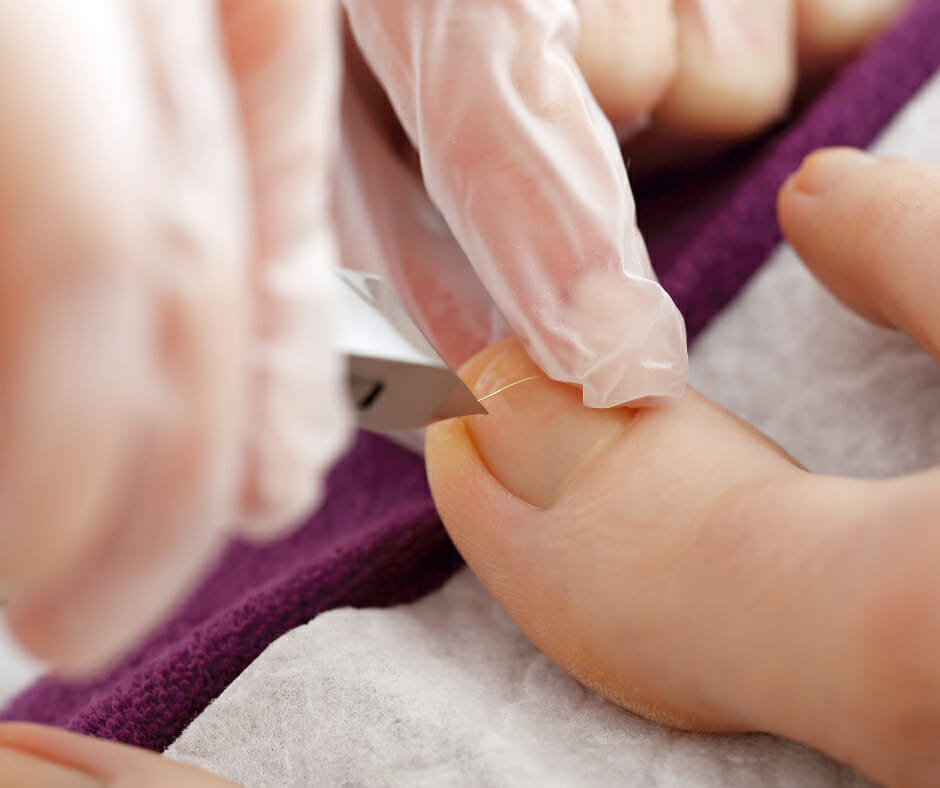What are Ingrown Toenails and What Causes Them?
Ingrown toenails are a common foot condition that can cause discomfort and pain and even lead to infection if left untreated. The condition occurs when the corner or side of a toenail grows into the surrounding skin, causing redness, swelling, and tenderness.
This can be caused by a variety of factors, including genetics, improper nail trimming, tight-fitting shoes, and injury to the toe. It can be painful and debilitating, and it is important to take steps to prevent and treat this condition as early as possible.

Preventing Ingrown Toenails
There are several steps you can take to prevent ingrown toenails from occurring:
- Wear comfortable shoes that fit properly: Tight-fitting shoes can put pressure on your toes, which can cause the nails to grow into the skin. Make sure to wear shoes that fit properly and provide enough space for your toes to move.
- Trim toenails straight across and avoid rounding the corners: When trimming your toenails, make sure to cut them straight across rather than curving them. This will help prevent the nail from growing into the skin.
- Keep feet clean and dry: Keeping your feet clean and dry can help prevent bacterial and fungal infections, which can make ingrown toenails worse.
- Avoid tight hosiery or socks: Tight socks or hosiery can put pressure on your toes and cause the nails to grow into the skin. Make sure to wear socks and hosiery that fit properly.
- Protect feet from injury: To avoid trauma to your toes, wear protective shoes or padding when participating in activities that may cause injury, such as sports.
Recognizing Ingrown Toenails
Some common symptoms of ingrown toenails include:
- Pain and tenderness
- Swelling and redness
- Fluid buildup around the affected toenail
- Difficulty wearing shoes or walking
Recognizing the signs and symptoms of an ingrown toenail is important to ensure early treatment. If you notice any of these, it is important to seek medical attention right away to prevent the infection from spreading.
Treating Ingrown Toenails
If you have an ingrown toenail, there are several home remedies you can take to treat it:
- Soak the affected foot in warm water: Add Epsom salts or mild soap to help reduce swelling and ease the pain. Soak the foot for 15-20 minutes, 2-3 times per day until the pain and swelling subside.
- Gently lift the corner of the toenail out of the skin: Use a clean and sterile tool, such as tweezers, and be very gentle to avoid causing further pain or damage to the nail and surrounding skin.
- Place a small piece of cotton or dental floss under the nail: Make sure to use a small amount that is just enough to lift the nail slightly and relieve the pressure on the skin. Do not force too much cotton or floss under the nail, as this can cause further discomfort and damage.
- Apply an antiseptic and bandage the toe: Use a clean and sterile bandage and make sure to change it daily. It is important to keep the area clean and dry to prevent infection and promote healing.
- Take over-the-counter pain relievers if necessary: If you experience pain or discomfort, over-the-counter pain relievers can help alleviate the symptoms.
When to See a Foot Doctor
While most cases of ingrown toenails can be treated at home, there are certain situations in which medical attention is necessary. If you experience severe pain or swelling that does not improve with home treatment, you should see a foot doctor. Additionally, if you also notice any signs of infection such as fever, chills, or drainage from the affected toe, it is important to seek medical attention right away. People with diabetes or poor circulation should also consult a doctor if they develop an ingrown toenail, as the condition can lead to serious complications.
Conclusion
In conclusion, ingrown toenails can be painful and uncomfortable, but they are also preventable and treatable. By taking steps to prevent and recognizing the symptoms early, you can avoid complications and get back to your normal activities quickly. Remember to wear comfortable shoes, trim your toenails properly, keep your feet clean and dry, and protect your feet from injury to prevent ingrown toenails. And if you do develop an ingrown toenail, don’t hesitate to contact a podiatrist to get the treatment you need.



